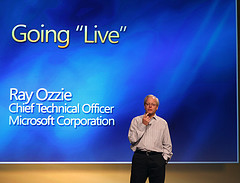Ray Ozzie on Adobe and software as a service

Knowledge@Wharton just published an interview that Kendall Whitehouse did with Ray Ozzie in which he talks about Microsoft, software as a service, and a little bit on Adobe:
In the docs and spreadsheets realm, I believe there are certain uses of spreadsheets in particular, where the sharing model [enabled by] using it up on a service could be really useful. I think that there are other scenarios where you want it on your laptop. As a company, Microsoft views this as an opportunity -- to deliver the aggregate productivity value in all places.
Adobe is a great example. Flash is a rich client; it's rich code delivered to the edge. It's not a centralized model; it's a decentralized model. It just happens to be tethered to the service.
If anybody has a software and services model, it's Adobe, because of that rich [Flash Player] applet that they extend the browser with. The more they enhance that, as you can see in their Flex and Apollo plans, the more it becomes this unified software and service vision, which is basically the same as Microsoft's vision.

There is also an interesting quote from Ray after being asked how important being cross-platform is to Microsoft:
The guidance that we are giving the development community -- and the guidance that we use in-house -- is to look at applications through the following lens: When the business model behind that app means that you have to get it everywhere, we call that the "universal web application pattern." When the most important thing is the experience that the user has with that application and you might be willing to trade off the breadth of the web for the richness of that experience, we call that an "experience first pattern."
In our space, we're seeing that play out with things like ASP.NET AJAX, which falls under the category of "universal web application platform" and Windows Presentation Foundation, which obviously falls under the "experience first pattern". But "WPF/E" is still the wildcard. It's a bridge between the two mindsets, but we have yet to see which one it is going to be most closely associated with. Experience is a huge deal to Microsoft, and they see it as a value add, and a reason to adopt their platform. But the web experience is become richer and richer, so if they really do believe experience is important, they should put a lot of support behind "WPF/E". I guess we'll see what happens at MIX.
Image credit to Niall Kennedy.